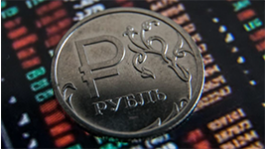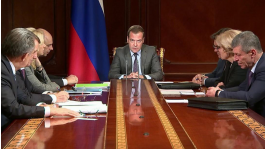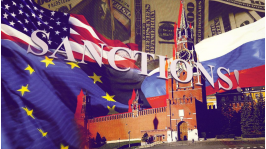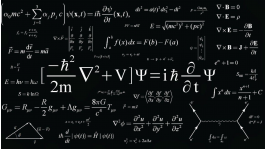Preliminary note
It is very difficult to assess the validity of the quantitative parameters since the methodology and methods for the Forecast used by the authors are not known (indirect indicators point that it is based on the current trends in the Russian and world economies). First of all, the assessment of the Forecast was carried out from the point of view of its compliance with the goals of social and economic development as defined in Decree of the President of the Russian Federation dated 07.05.2018 No. 204.
Evaluation of the forecasted rates of social and economic development
It should be noted that the economic growth rates covered in the Forecast do not allow to realize the goal set in the Address of the President of the Russian Federation to the Federal Assembly dated 03.01.2018 to increase GDP per capita by 1.5 times by 2024. Considering the projected (according to the base and target options) population, this requires that the average annual GDP growth rates in 2019–2024 amounted to 7.2%, while in the target option they are 2.6 times lower (2.8%). Such rates do not allow increasing the income of the population which is the basis for social development. Thus, projected in the base case, the average annual growth of real disposable income of the population in 2019–2024 equal to 1.8% means that by 2024, the level of 2013 (101%) will be restored and followed by decline. In this case, it is not clear how a two-fold reduction in the share of the population will occur: their income will be below the subsistence level (6.6%) if the real disposable income remains at the level of 2013 when this share was 10.8%.
The evidence from overseas experience shows that the increase in the selective policy for disadvantaged population observed in recent years (emphasis on means testing while tightening requirements) conserves poverty, and the tightening of fiscal and monetary policies (adequately described in the initial sections of the Forecast) increases the number of disadvantaged citizens, classified as poor by the OECD standards.
It is noteworthy that the Forecast does not mention the dynamics of overcoming income inequality.
Factors of social and economic development
External factors
The Forecast seems to rightly note the instability of the world economy and high risks of its further slowdown (the Forecast suggests more pessimistic estimates: the growth of world GDP below 3% in 2019 compared to 3.2% according to the IMF forecast) and, as a result, “contraction” of world markets. In this regard, the orientation toward expanding exports as an economic growth driver does not seem entirely logical. Developing domestic demand seems to be more important in these circumstances. The Forecast mentions a drop in export prices for energy and raw materials as the most important consequences of such a slowdown for the Russian economy. This indicates the continued dependence of the raw materials of the Russian economy.
Current dynamics of the Russian ruble exchange rate does not confirm that “it is forecasted that the consistent implementation of macroeconomic policies within the framework of the budget rule will ensure that the exchange rate against the US dollar remains low depending on the dynamics of oil prices” (p. 10 of the Forecast). The evidence from practice shows that if the oil price in the world market rises, the ruble’s rate to the dollar is relatively stable. If the oil price falls steadily, then the Russian ruble, as a rule, wastes quickly. There has been significant volatility of the Russian ruble exchange rate in 2018–2019, intensified after the US government introduced the next sanctions against Russian companies and individuals, as well as increased uncertainty in the energy markets. According to the Bloomberg terminal, on August2, 2019, the Russian ruble climbed to the fourth place among the most volatile currencies with an indicator of 10% [1] after the South African rand (15%), Turkish lira (14.5%) and Brazilian real (12.42%). Over the previous two months, the ruble was on the 7–8th position of the ranking [2].
Internal factors
Investment activity
The Forecast indicates a slowdown in investment activity. The growth in investment in fixed assets in January – June 2019 amounted to 0.6% compared to 4.3% for the same period in 2018. This led to a decrease in the expected results in 2019 in comparison with the September forecast for 2018 (2.0% compared to 3.1%, respectively). In 2020 they forecast a sharp increase in investments (5.0%) which is supposed to be retained as an average annual indicator until 2024.
We will not discuss if this rate of investment growth is sufficient to solve the problems of breakthrough technological and social and economic development indicated in Decree No. 204. The factors that provide the predicted growth are not convincing enough.
The credit cycle development based on the recovery of business sentiment is indicated as a growth driver of investment activity. However, the reliability of this factor is doubtful: business sentiment may change in the result of various shocks and the borrowed nature of investments itself makes the investment process expensive and unreliable.
The forecast of increasing growth rate of investments in fixed assets to 5% in 2020 and 6.5% in 2021 (p. 25) seems contradictory, while the Ministry of Finance and the Bank of Russia’s rigid guidelines for priority ensuring financial and price stability are maintained.
The mining industry remains the main direction for investments – 25.9%, while the manufacturing industry accounts for only 17.5% (an increase of only 1.3% compared to 2018). As a result, the share of the manufacturing industry in 2024 will be 12.7% compared to 12.3% in 2018. The 0.4% change does not imply any future noticeable shifts in the structural adjustment of the economy. Therefore, it is unclear how manufacturing combined with the projected contraction of foreign markets will become drivers of economic growth due to export orientation.
The expectations of a decrease in the net capital outflow from the country in 2019 to the GDP level of 1.4% compared to 2.2% in the April forecast seem too optimistic.
According to the Bank of Russia, the capital outflow from Russia sharply increased in 2018-2019: in 2018, it grew 2.7 times compared to the previous year – up to $ 67.5 billion [3]. In January – August 2019, it also increased 1.3 times – up to $ 26.1 billion compared to $ 20.6 billion for the same period in 2018 [4].
Labor productivity
The projected growth rates of labor productivity (2.3% of the average annual growth in the base case to 2024) prove that this factor is the main factor for economic growth under the current conditions (the projected average annual GDP growth in the base case for the same period is 2.6%). Thus, low growth rates of labor productivity do not allow reaching the target indicators of economic growth.
At the same time, the Forecast does not analyze how to increase the annual labor productivity by at least 5% by 2024 at 10.000 medium and large enterprises of the basic non-primary sectors of the economy as suggested by Decree No. 204.
Given the objective necessity for fast recovery of income lost in the 2014–2015 crisis, such low growth rates of labor productivity result in violating the core principle of the excess of labor productivity growth rates over wage growth rates; sustainable development is impossible without it.
In 2020, the growth rate of labor productivity in the three scenarios – basic, conservative, and target – will be lower than the growth rate of real wages (appendix tables on pages 105–110 of the Forecast). The indicated lag in productivity is significant: in the conservative scenario – by 63.6%, in the base scenario – by 29.4%, and in the target scenario – by 30.0%. Although the text of the document partially explains this economic incident, its scale seems to be too significant. In fact, this means that in 2020 wage growth will go to the detriment of economic profitability which contributes to developing recessive trends and a monetary overhang in the consumer market.
In subsequent years, the rule of outstripping growth in labor productivity is not formally violated. However, the basic scenario runs along the very edge of the criterion: in 2024, the rates of labor productivity and real wages coincide, and in 2022–2023, the difference between them is only 0.1 percentage points. The reason is not the excessively high growth rates in wages (they are just low), but the low growth rates in labor productivity.
Technological re–equipment
Low productivity growth rates are largely due to the outdated technological base of the economy. That is why, Decree No. 204 set the task of breakthrough technological development as a primary goal.
Actually, the Forecast does not pay due attention to this primary task (the super task, as noted in the speech of the President of the Russian Federation at the meeting with the Council of Legislators on April 24, 2019).
As a result, the Forecast does not present the dynamics of innovative activity of enterprises in the technological field, and it remains unclear whether by 2024 at least 50% of enterprises will carry out technological innovations annually as formulated in Decree No. 204. It should be remembered that a similar task was set in the Concept 2020 approved in 2008. However, the innovative activity of industry has not actually changed by 2018. In this regard, it is unclear how this goal is supposed to be achieved [5].
Table 7 on p. 20 of the Forecast indicates two measures as tools to facilitate accelerated technological development: to implement technological development programs focused on artificial intelligence, the Internet of things, robotics and the development of digital platforms; to create a system of innovation centers. Meanwhile, these two areas of regulatory efforts seem to be secondary. For example, creation of innovation centers and valleys like Skolkovo or Lomonosov Moscow State University has virtually no effect on the technological re–equipment of the Russian economy. Similarly, artificial intelligence systems, the Internet of things, robotic programs, and digital platforms alone do not upgrade the manufacturing base of manufacturing industries and companies. The document does not mention a fundamentally important idea of the large–scale borrowing of technologies that Russian enterprises lack sorely. The foresaid demonstrates that the discrepancy in the forecast figures and planned real economic measures. In fact, the forecast document does not indicate the real sources of technological re–equipment of the domestic economy.
Of particular concern is the fact that the Forecast does not mention such a basic condition of technological re–equipment as the development of machine– tool production; its lag is both critical in terms of production volumes and technological level, including from the point of view of technological import dependence.
Due to this, the relatively high increase of capital investment is well marked in contrast to the insignificant innovation investment in economic growth. Regarding industry, it is mainly explained by the increase in state order (p. 38), which is not accompanied by effects in terms of key characteristics of production development, i.e. growth in labor productivity and other performance indicators (see Industry section of Appendix 1).
Domestic demand
The Forecast (p. 3) notes that a slowdown factor of economic growth is the slowdown in aggregate demand growth, whose weakness is indicated by the rapid decline in inflation in 2019. This statement seems strange for the following reasons:
• first, we believe that the decline in demand is caused by a fall in household incomes the forecast for 2020 notes that real consumer incomes will be increased, but the mechanism to achieve this growth is not indicated);
• second, the decrease in inflation is largely due to the synchronously tight monetary policy of the Bank of Russia and the fiscal policy of the Ministry of Finance of the Russian Federation. The Ministry of Economic Development communicates with them quite closely when developing anti–inflation policy measures. At the same time, the Forecast states that inflation in Russia is largely non–monetary in nature.
The section on policies regarding the so–called natural monopolies does not intend to conduct an audit of gas, electricity, transportation, etc. prices – it only says about price indexation. It is here that cost inflation is mostly formed contributing to fading activity of manufacturing enterprises and taking considerable funds from the population (payments for utilities).
Economic policy coordination
We can’t ignore the fact that the Forecast allowed the diminution of the role of the financial sector in achieving the parameters of the country’s economic development. The state and development of the financial market, including the banking sector (lending volumes, indicators of financial stability), as a factor influencing the social and economic development of the country, is not specifically considered. In this regard, the financial (banking) resource component of the forecasts is absent. Just certain parameters of monetary policy are presented – the ruble exchange rate, inflation, etc. Unlike the previous forecasts, this document does not contain a forecast for the monetary sphere. It is just mentioned that the risk of social and economic development of Russia is an unjustified growth in consumer lending. It is advisable that the Ministry of Economic Development of the Russian Federation, together with the Bank of Russia, developed directions of state banking policy in the context of achieving national goals and key priorities, and the formation of domestic investment demand. We consider this condition important in the context of a remaining bank–oriented model of the Russian financial market and the role in the economy and in the implementation of national projects that development banks could play.
It is also important that this Forecast be supplemented by a forecast for the banking sector and the financial market as a whole, agreed with the Bank of Russia. It is also necessary to assess elaboration and feasibility of a number of state development programs for the certain sectors of the economy, primarily in terms of the validity and security of their financial and credit resources based on the first implementation results, including the project financing program for housing construction, preferential mortgage lending, and educational loan as a tool for developing human capital.
The document must identify the opportunities for creating internal financial resources, promoting investments, including mechanisms for subsidizing interest rates, as well as effective implementing investment projects with the state participation; emphasize the need for more active and large–scale involvement of Russian banks to solve the tasks. The following suggestions would certainly help:
- to increase the volume of investments and improve the efficiency of their use, to enlarge a membership in state programs by including representatives of the private sector of the economy and effective credit institutions, not state owned and not systemically significant;
- to increase credit support for economic growth in the country by Russian commercial banks, given the limited external borrowing, significant easing of some regulatory requirements imposed by the Central Bank, and especially with regard to the commercial banks whose loan portfolios are dominated by high–tech and highly efficient real economy projects;
- to create conditions for non–governmental financial institutions in the country in order to expand financial support for the domestic economy.
In unstable global environments, in the sphere of monetary policy switching to flexibly regulated ruble exchange rate in a certain range to increase its role in maintaining financial and economic stability seems logical.
The responsibility for macroeconomic stability between exchange and monetary policies requires more even distribution that may lead to an increase of the inflation targeting benchmark above 4%.
On the one hand, justified by fundamental factors and regulated and projected for the future, the range of the exchange rate of the Russian currency would not lead to appreciation of imported equipment necessary for re–equipping the production base and producing competitive non–primary Russian products. On the other hand, it could provide sufficient profitability and growth of export earnings of Russian producers.
Non-monetary factors should be managed through comprehensive measures, as they affect various sectors of the Russian economy and imply interaction with federal and regional authorities. The Bank of Russia and the Ministry of Finance of the Russian Federation, the Ministry of Economic Development of the Russian Federation, and other ministries and departments should be in close cooperation, especially when forecasting their activities.
Experts from the Financial University have repeatedly emphasized this aspect and have proposed measures to coordinate various areas of state economic policy [6].
The lack of coordination is exemplified by the fact that the parameters of this forecast do not correspond to the forecast of the Bank of Russia included in the draft Guidelines for the Single State Monetary Policy in 2020 and for 2021 and 2022. According to the forecast of the Ministry of Economic Development, in 2020, inflation will be 3%, and according to the forecast of the Bank of Russia, it will be 4% in case of an optimistic and basic scenario and in the case of a risk scenario, it can reach 6.5–6.7%. Note that when making decisions the Bank of Russia will be guided by the approved Fundamentals of monetary policy. Therefore, a significant part of the measures in the Forecast may in fact be financially unsecured.
Risks for social and economic development
Section “Forecast risks for social and economic development” on p. 36 of the document identifies the main risks – stagnation of the global economy, deterioration of the consumer loan portfolio and slow implementation of structural reforms.
It seems that more significant risks are in the shortage or neutralization of sources of investment in fixed assets, slow technological re–equipment of the economy and the spontaneous release of workers due to the mass digitalization of production processes.
There are also risks of a steep decline in inflation, which does not correspond to the current internal and external conditions, on the one hand, and risks of high volatility of the ruble exchange rate, on the other.
Let’s bear in mind such risks as poverty of a significant share of the population, its social and economic stratification, as well as uneven development and situation of Russian regions.
The risks of emergence of social strain due to the actions of destructive socio–political groups and failures in implementing reforms in the pension sector, healthcare, and education were not assessed.
The following risks were not assessed either: labor emigration of talented youth capable of innovation, development of attitudes toward self–realization abroad among young people, and destructive factors lowering the profile of conscientious work.
Working Group Leaders: Dr. Sci. (Econ.) V.V. Maslennikov, Corresponding Member, RAS, Dr. Sci. (Econ.) D.E. Sorokin
Expert Working Group: Dr. Sci. (Eng.) N.M. Abdikeev, Dr. Sci. (Econ.) M.A. Abramova, Cand. Sci. (Econ.) O.U. Avis, Dr. Sci. (Econ.) O.A. Aleksandrova, Dr. Sci. (Econ.) E.V. Balatskii, Dr. Sci. (Econ.) V.P. Bauer, Dr. Sci. (Phys. –Math.) Yu.S. Bogachev, Leading Researcher N.А. Ekimova, Cand. Sci. (Econ.) V.V. Eremin, Dr. Sci. (Econ.) E.A. Zvonova, Cand. Sci. (Econ.) S.V. Zubkova, Cand. Sci. (Econ.) Yu.P. Kalmykov, Dr. Sci. (Soc.) M.V. Kibakin, Dr. Sci. (Econ.) N.V. Kuznetsov, Dr. Sci. (Econ.) O.I. Lavrushin, Dr. Sci. (Econ.) I.V. Larionova, Cand. Sci. (Econ.) E.I. Meshkova, Cand. Sci. (Econ.) E.L. Moreva, Cand. Sci. (Eng.) L.V. Obolenskaya, Dr. Sci. (Econ.) V.Ya. Pishchik, Cand. Sci. (Econ.) S.A. Pobyvaev, Dr. Sci. (Econ.) O.S. Rudakova, Dr. Sci. (Econ.) A.I. Selivanov, Dr. Sci. (Econ.) S.N. Sil’vestrov, Dr. Sci. (Econ.) V.G. Starovoitov, Dr. Sci. (Econ.) A.A. Tkachenko, Dr. Sci. (Soc.) A.G. Tyurikov, Researcher M.A. Yurevich.
[1] The ruble volatility per month is calculated based on the prices of monthly options for the dollar against the ruble.
[2] The ruble went higher in the ranking of the most volatile currencies after the new US sanctions. 07.08.2019. URL: https:// www.rbc.ru/finances/07/08/2019/5d49a6b09a79473e323fbd4b (accessed on 04.10.2019).
[3] Capital outflow from Russia increased 2.7 times in 2018. Vedomosti.17.01.2019. URL: https://www.vedomosti.ru/eco-nomics/news/2019/01/17/791702-ottok-kapitala (accessed on 01.10.2019).
[4] Capital outflow from Russia increased 1.3 times in eight months. 10.09.2019. URL: https://www.interfax.ru/business/675921 (accessed on 02.10.2019).
[5] Note that assessing the innovation activity effects and innovation contribution to economic development (one of its components is presented on page 23 of the Forecast), as well as identifying innovations with the TFP component from the Cobb–Douglas production function require a special justification. For several decades they have been emphasizing and explaining the illegality of this approach in the specialized literature.
[6] The importance of coordinating various directions of state economic policy to ensure sustainable economic growth has been written over several years by scientists of the Financial University while preparing expert opinions on the draft “Guidelines for the Single State Monetary Policy”, as well as they substantiated the position in monographs and articles, speeches at scientific conferences, as part of participation in the work of the Stolypin Club; Monetary policy of Russia: new challenges and prospects. Monograph. Eskindarov M.A., ed. M.: Knorus; 2016; Fiscal and monetary instruments to achieve financial stability and ensure economic growth. Monograph. Abramova M.A., ed. M.: Knorus; 2017; Eskindarov M.A., Maslennikov V.V., Abramova M.A., Lavrushin O.I., Goncharenko L.I., Solyannikova S.P., Morkovkin D.E., Abdikeev N.M. Strategy of the CSR 2018–2024: slogans, myths and reality (position of experts at the Financial University). Vestnik Finansovogo universiteta – Bulletin of the Financial University, 2017; 21(3): 6–24.
Official link to the article:
Assessment of Forecast of Social and Economic Development of the Russian Federation for 2019–2024 (September, 2019) // «Finance: Theory and Practice», Vol. 23, No. 5, 2019. Р. 126–130.









